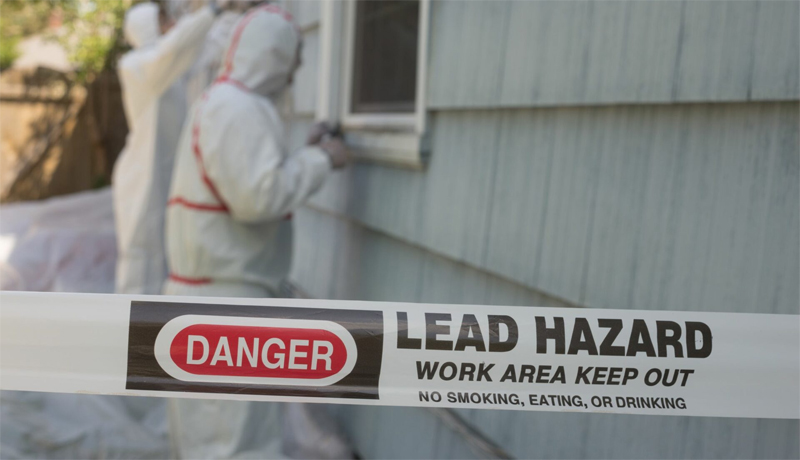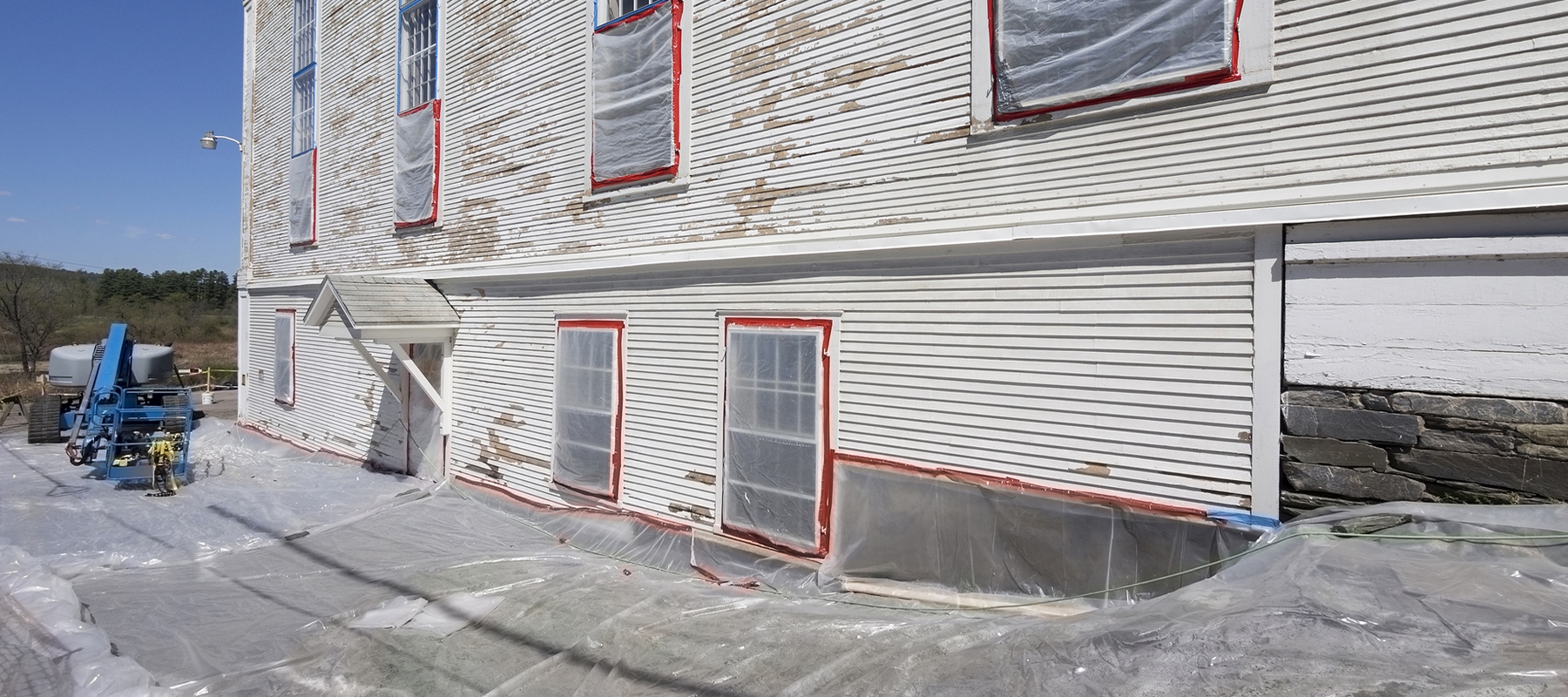Lead Paint Removal Costs: Regulations, Safety, and What to Expect
Last Updated: October 03, 2023

Fact Checked By: Ryan Maguire
On This Page
If testing turns up the presence of lead-based paint in your home or property, you can choose to eliminate the hazard permanently through abatement, which is strictly regulated by the Environmental Protection Agency (EPA).
The EPA also regulates renovation, repair, and painting (RRP) projects that take place in buildings constructed prior to 1978 (the year that lead-based paint was banned).
Lead Paint Removal Costs #
Removing lead-based paint is recommended if flaking, chipping, or deteriorating paint is present. Complete abatement involves permanently eliminating lead hazards.
Typical costs include:
Lead paint stripping using chemicals:
- $4 to $8 per sq ft for wood, metal, masonry
- $8 to $16 per sq ft for porous surfaces
Encapsulation with new paint coat:
- $6 to $11 per sq ft for properly prepared surfaces
Enclosure with drywall, paneling, etc:
- $7 to $15 per sq ft depending on method
Component replacement (windows, trim, doors):
- $300 to $1,000 per window
- $10 to $25 per sq ft for trim
- $250 to $1,000 per door
Full abatement for entire home:
- $8,000 to $25,000+ for a typical single family house
Abatement requires proper containment, waste disposal, and site remediation.
Certain households are eligible for low-finance government loans to help with the cost of lead abatement. Visit HUD.GOV or contact the National Lead Information Center (NLIC) to learn more.
Comprehensive lead resources can be found at epa.gov.
Lead Paint Removal Cost Examples #
We ask several homeowners and companies how much they paid for lead paint abatement:
A homeowner in Iowa had lead paint stripped from all wood trim and doors in a 1500 sq ft home built in 1920. The total cost was $9,750.
A landlord in Rhode Island hired contractors to encapsulate lead paint on the interior and exterior of a 4-unit rental property constructed in 1940. Encapsulation for the 8000 sq ft building totaled $48,000.
A family in Wisconsin removed and replaced all windows in their 980 sq ft starter home built in 1955. The total window replacement cost was $4,500.
A school district in New Mexico completely abated lead paint hazards in a 25,000 sq ft elementary school built in 1925. Full abatement of all painted surfaces cost $198,000.
A manufacturer in Michigan enclosed lead-based interior and exterior paint with drywall and metal siding on their old 12,000 sq ft industrial warehouse. Enclosure costs totaled $92,000.
A church in Pennsylvania stripped lead paint from all original stained glass windows and encased with protective glazing. The project cost $22,000 to complete.

EPA RRP Rule for Lead Paint #
The RRP Rule stands for the Renovation, Repair and Painting Rule regarding lead paint.
Requires EPA certification for firms doing renovation, repair or painting projects in pre-1978 homes, childcare facilities, and schools.
Applies to projects disturbing lead paint over 6 sq ft indoors or 20 sq ft outdoors.
Firms must follow lead-safe work practices for:
- Containment
- Cleaning
- Proper waste disposal
Certified contractors must provide:
- Lead pamphlet
- Records showing compliance
Aims to protect against lead exposure from improper renovation activities.
EPA or states can inspect sites and issue fines for non-compliance.
Provides important protections against lead hazards from renovation work in older homes.
Can I Remove Lead Paint Myself? #
It is not recommended for homeowners to remove lead paint themselves due to the serious health risks.
Improper lead paint removal can increase exposure through lead dust and debris.
The EPA RRP Rule requires certification for paid contractors disturbing lead paint to follow strict lead-safe processes.
There are no specific regulations for DIY work, but lead-safe methods should still be used:
- Proper containment and ventilation
- Wet scraping and sanding to reduce dust
- Thorough cleanup using HEPA vacuums
Full lead abatement requires specialized equipment and waste disposal that is very difficult DIY.
Minor projects like repainting small areas may be DIY, but scope should be limited.
Hiring a certified professional is highly recommended for any significant lead disturbance.
Protect yourself and your family by using certified lead contractors for renovation projects in pre-1978 homes.
In summary, DIY lead paint removal is not advised. Safest option is hiring an RRP certified professional.
Is Abatement Necessary? #
Lead abatement isn't required by law. The owners of rental properties, however, have a legal obligation to inform tenants of a positive lead test (read more about renters' rights).
A landlord who knows that lead is present and does not disclose this information may be subject to legal action.
Lead paint must also be disclosed in the event of a home sale.
When determining whether or not to perform lead abatement in your home, a couple of factors should be considered. Lead poses the greatest risk to children, especially those aged 1-5. Households with children over the age of six or childless households might choose to leave lead-based paint that's in good condition (not chipping or otherwise at risk of producing dust) untouched.
But, if you have children under the age of six living with you or visiting regularly and there is peeling or chipping lead-based paint in the home, abatement should be performed.
What is Involved in Lead Abatement? #
Lead abatement aims to permanently eliminate lead-based paint hazards.
Full abatement involves removing, sealing, or enclosing lead paint to prevent exposure.
Abatement methods include:
- Stripping paint off surfaces
- Encapsulating lead paint with new coatings
- Enclosing lead paint behind new walls/ceilings
- Replacing components like windows
Extensive containment and prep work is required to prevent lead contamination.
Special equipment like HEPA vacuums control lead dust.
Waste must be disposed of according to hazardous waste regulations.
Clearance testing is conducted afterward to validate lead hazards are gone.
EPA or state certified abatement contractors should perform the work.
Abatement involves comprehensive processes and strict protocols to completely eliminate lead risks.
It is more extensive than interim lead hazard control methods.
